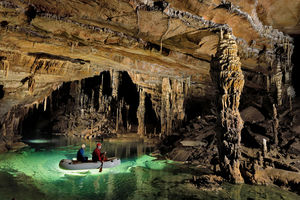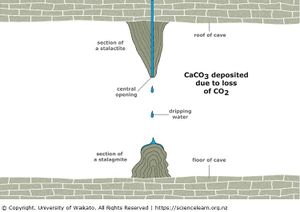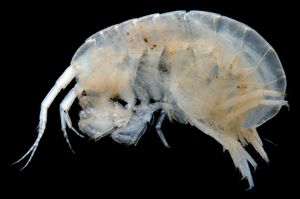Subterranean Ecology: Difference between revisions
No edit summary |
No edit summary |
||
| Line 1: | Line 1: | ||
[[File:guys bruv.jpg|thumb|right|The Krizna Jama "Cross Crave" in Slovenia. The cave system is filled with interconnected emerald green pools that are fed by the Bloke plateau]] Subterranean ecology is a branch of biology of which studies the interaction of organisms under the earth’s surface. Subterranean environments include places like caves, underground waters, chasms, rock overhands, etc. Caves are the most promiminant location to find a vast amount of subterranean organisms interacting with each other. This epigean realm has yet to be fully understood and is mostly characterized as locations with littler to night. Total darkness is common within these environments and gives organisms a challenge to live without life. Subterranean fauna mostly | [[File:guys bruv.jpg|thumb|right|The Krizna Jama "Cross Crave" in Slovenia. The cave system is filled with interconnected emerald green pools that are fed by the Bloke plateau]] Subterranean ecology is a branch of biology of which studies the interaction of organisms under the earth’s surface. [4] Subterranean environments include places like caves, underground waters, chasms, rock overhands, etc. Caves are the most promiminant location to find a vast amount of subterranean organisms interacting with each other. This epigean realm has yet to be fully understood and is mostly characterized as locations with littler to night. Total darkness is common within these environments and gives organisms a challenge to live without life. Subterranean fauna mostly consists of arthropods, invertebrates, and some vertebrates such as cave salamanders. There is much to be learned about subterranean ecology due to its difficulty to explore its environments. | ||
| Line 8: | Line 8: | ||
[[File:caves.jpg|thumb|left|Diagram of cave showing formation of stalagmites and stalactites]]Caves are the most common environments for subterranean ecology. A cave, also called cavers, is a natural opening in the earth, formed through various types of natural processes. Most caves are formed by a chemical reaction between groundwater and bedrock composed of limestone dolomite. Rain water picks up carbon dioxide from the wait as it penetrates the soil, turning into a weak acid. | [[File:caves.jpg|thumb|left|Diagram of cave showing formation of stalagmites and stalactites]]Caves are the most common environments for subterranean ecology. A cave, also called cavers, is a natural opening in the earth, formed through various types of natural processes. Most caves are formed by a chemical reaction between groundwater and bedrock composed of limestone dolomite. Rain water picks up carbon dioxide from the wait as it penetrates the soil, turning into a weak acid.[2] | ||
The acid-forming reaction is: H2O + CO2 --> H2CO3 (carbonic acid). | The acid-forming reaction is: H2O + CO2 --> H2CO3 (carbonic acid). | ||
| Line 14: | Line 14: | ||
The solution of water and carbonic acid then seeps down into the limestone. The acid reacts with the calcite to dissolve it in the liquid. | The solution of water and carbonic acid then seeps down into the limestone. The acid reacts with the calcite to dissolve it in the liquid. | ||
CaCO3 + H2CO3 --> Ca+2 + 2(HCO3-) (calcium bicarbonate solution). | CaCO3 + H2CO3 --> Ca+2 + 2(HCO3-) (calcium bicarbonate solution). [3] | ||
Over time, the limestone or dolostone dissolves, creating massive pockets under the earth’s surface. Cave passages usually move through the water table of an aquifer. Water from an aquifer can reroute its path into the caves, which will dictate if the cave will be wet or dry. | Over time, the limestone or dolostone dissolves, creating massive pockets under the earth’s surface. Cave passages usually move through the water table of an aquifer. Water from an aquifer can reroute its path into the caves, which will dictate if the cave will be wet or dry. [3] | ||
| Line 23: | Line 23: | ||
Subterranean fauna are decribed as organisms that live below the surface of the earth. They are divided into two groups: troglofauna and stygofuana. Trogofauna are air breathing and live in caves and voids. Stygofauna are aquatic and live in groundwater. Most fauna have reduced pigment and non functioning eyes. Invertebrates dominate subterranean fauna. Some vertebrates, like the blind snake, or the pilabra can be found in these special environments. Troglofauna include, millipedes, beetles, crickets and other organisms that are able to live in caves. Troglofuana represent an example of adaptation in extreme environments Stygofauna live in freshwater aquifers. Stygofauna include gastropods, isopods, fishes, and salamanders. Stygofuana are able to navigate through the aquifer without any vision | Subterranean fauna are decribed as organisms that live below the surface of the earth. They are divided into two groups: troglofauna and stygofuana. [1] Trogofauna are air breathing and live in caves and voids. Stygofauna are aquatic and live in groundwater. Most fauna have reduced pigment and non functioning eyes. Invertebrates dominate subterranean fauna. Some vertebrates, like the blind snake, or the pilabra can be found in these special environments. Troglofauna include, millipedes, beetles, crickets and other organisms that are able to live in caves. Troglofuana represent an example of adaptation in extreme environments Stygofauna live in freshwater aquifers. Stygofauna include gastropods, isopods, fishes, and salamanders. Stygofuana are able to navigate through the aquifer without any vision. [1] | ||
[[File:stygofauna.jpg|thumb|right|Stygofauna]] [[File:trogofauna.jpg|thumb|left|Trogofauna]] | [[File:stygofauna.jpg|thumb|right|Stygofauna]] [[File:trogofauna.jpg|thumb|left|Trogofauna]] | ||
== References == | |||
1. Subterranean Fauna (stygofauna and troglofauna). (n.d.). Retrieved from http://www.bennelongia.com.au/services/subterranean-fauna/ | |||
2. How caves form. (n.d.). Retrieved from https://www.bgs.ac.uk/mendips/caveskarst/caveform.htm | |||
3. Cave Geology in Depth. (n.d.). Retrieved from https://www.nps.gov/grba/learn/nature/cave-geology-in-depth.htm | |||
4. Shone, R. (2017, November 08). Go Inside These World-Famous, Rarely Seen River Caves. Retrieved from https://www.nationalgeographic.com/adventure/destinations/europe/slovenia/photos-hidden-river-caves/ | |||
Revision as of 08:31, 9 May 2018

Subterranean ecology is a branch of biology of which studies the interaction of organisms under the earth’s surface. [4] Subterranean environments include places like caves, underground waters, chasms, rock overhands, etc. Caves are the most promiminant location to find a vast amount of subterranean organisms interacting with each other. This epigean realm has yet to be fully understood and is mostly characterized as locations with littler to night. Total darkness is common within these environments and gives organisms a challenge to live without life. Subterranean fauna mostly consists of arthropods, invertebrates, and some vertebrates such as cave salamanders. There is much to be learned about subterranean ecology due to its difficulty to explore its environments.
Caves

Caves are the most common environments for subterranean ecology. A cave, also called cavers, is a natural opening in the earth, formed through various types of natural processes. Most caves are formed by a chemical reaction between groundwater and bedrock composed of limestone dolomite. Rain water picks up carbon dioxide from the wait as it penetrates the soil, turning into a weak acid.[2]
The acid-forming reaction is: H2O + CO2 --> H2CO3 (carbonic acid).
The solution of water and carbonic acid then seeps down into the limestone. The acid reacts with the calcite to dissolve it in the liquid.
CaCO3 + H2CO3 --> Ca+2 + 2(HCO3-) (calcium bicarbonate solution). [3]
Over time, the limestone or dolostone dissolves, creating massive pockets under the earth’s surface. Cave passages usually move through the water table of an aquifer. Water from an aquifer can reroute its path into the caves, which will dictate if the cave will be wet or dry. [3]
Subterranean fauna
Subterranean fauna are decribed as organisms that live below the surface of the earth. They are divided into two groups: troglofauna and stygofuana. [1] Trogofauna are air breathing and live in caves and voids. Stygofauna are aquatic and live in groundwater. Most fauna have reduced pigment and non functioning eyes. Invertebrates dominate subterranean fauna. Some vertebrates, like the blind snake, or the pilabra can be found in these special environments. Troglofauna include, millipedes, beetles, crickets and other organisms that are able to live in caves. Troglofuana represent an example of adaptation in extreme environments Stygofauna live in freshwater aquifers. Stygofauna include gastropods, isopods, fishes, and salamanders. Stygofuana are able to navigate through the aquifer without any vision. [1]


References
1. Subterranean Fauna (stygofauna and troglofauna). (n.d.). Retrieved from http://www.bennelongia.com.au/services/subterranean-fauna/
2. How caves form. (n.d.). Retrieved from https://www.bgs.ac.uk/mendips/caveskarst/caveform.htm
3. Cave Geology in Depth. (n.d.). Retrieved from https://www.nps.gov/grba/learn/nature/cave-geology-in-depth.htm
4. Shone, R. (2017, November 08). Go Inside These World-Famous, Rarely Seen River Caves. Retrieved from https://www.nationalgeographic.com/adventure/destinations/europe/slovenia/photos-hidden-river-caves/